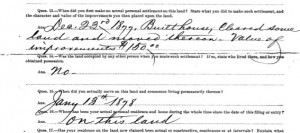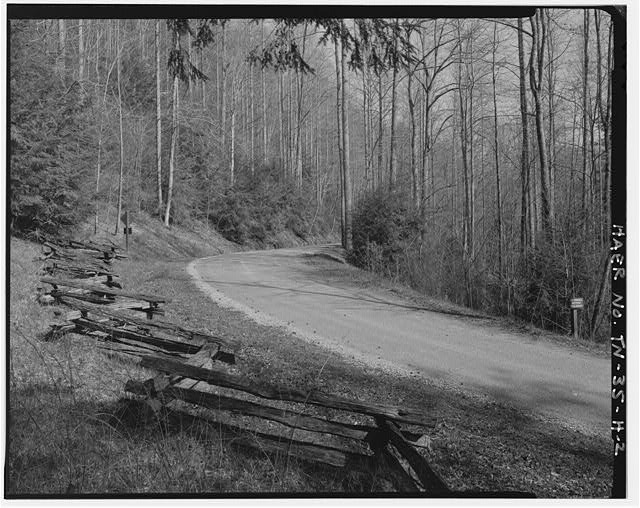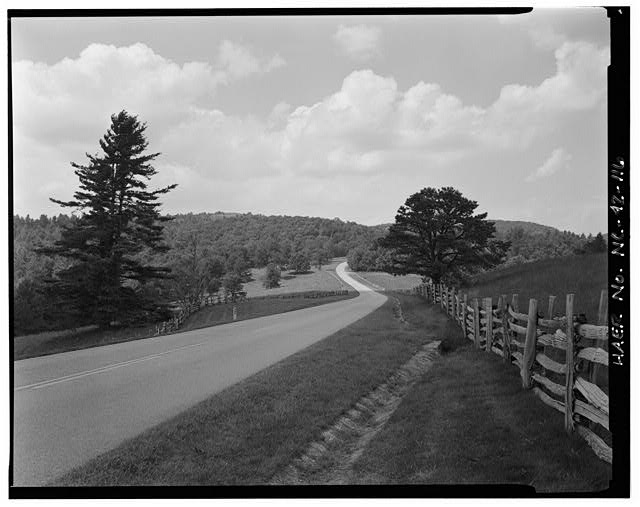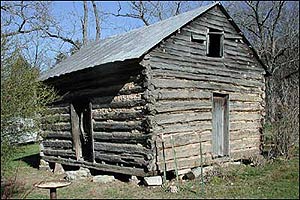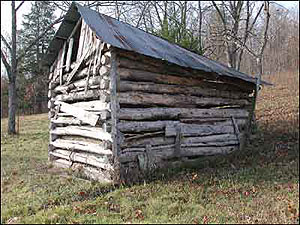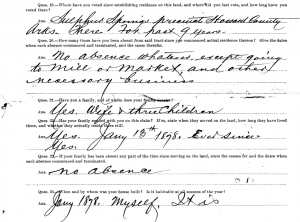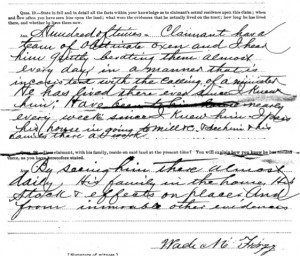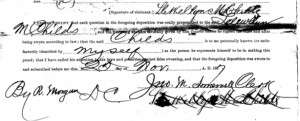Lewellen Moore Childs (1851-1915) settled his homestead in 1877-1878, about the same time as the Brock siblings did. While the Brocks settled their homestead as a family of five adults, the Childs homestead was settled by newlyweds. In 1877, the Brock family, John and Sarah, and their three children still at home, Lucinda, Permelia Caroline and Lawrence, ranged in age from 77 to 35. In contrast, Lewellen was 26 and his wife, 18, when they moved onto their homestead.
Lewellen (“Lewis”) married Martha Tennessee Fite in Montgomery County, Arkansas in June 1877. Six months after they married, he went off to Howard County to build a house. Fortunately, he was a fast builder. He went down there just before Christmas, and built the house. They moved in January 13, 1878, a Sunday. Six months later, Seady Tennessee Childs was born.
His application says he was farming in Montgomery County. Mother and I went to Montgomery County earlier this June, and didn’t find any sign of land ownership there. Of course, that’s not to say he wasn’t farming – just that it wasn’t his land.
He and Tennessee, daughter Seady, and a boarder Columbus Barnes are there in the 1880 census, next to his niece Asenath Ann (nee Pearson) Ross and her family.
I imagine that Columbus Barnes moved to Sulphur Springs Township because his brothers John T. Barnes and Adolph Barnes are living there. (They are on the previous page of the 1880 census.) Columbus eventually moved back to Sevier County and married a woman named Lyda Jane DeMoss. Their several children included a son named Carl Marx Barnes, possibly suggesting something about his political beliefs. (The son eventually went by Carl Mark Barnes.)
Lewis waited to enter his homestead application until January 1882 – four years after he built the house. (We saw a similar delay with the Brock sisters, who waited nearly six years from building their first house in 1877 to actually enter their homestead applications in October 1882.)
When they moved onto the land, they found oak, hickory, pine, and dogwood and cleared a quarter of it to use for fencing and firewood. He doesn’t mention using any to build his house, but it’s unlikely he would have brought in logs from somewhere else.
I wonder what the fences looked like. Research shows that fences around Elkhorn Tavern in 1862, at the time of the Battle of Pea Ridge up here in northwest Arkansas, included worm rail, stake and rider, and post and rail. I didn’t know any of those terms so I looked them up.
- Worm rail seems to be synonymous with what I think of as a split rail fence, where you don’t use posts or nails and the rails are interlocking and zigzag like a worm across the land. (I remember my grandfather Gordon Hartrick had a worm rail fence in his back yard in Ashley County which he had salvaged from a much older home place — perhaps it was of a similar age to Lewis’s home place.)
- Stake and rider is another form of rail fence made without needing to dig post holes. You can’t really tell from this photo, but, from what I’ve read, there are stakes crossed like an X. These crossed stakes hold up a horizontal rail, and you might then secure the horizontal rail at the intersection of the crossed stakes. You need another crossing for each horizontal rail.
- Post and rail requires post holes, and the rails are slotted through the posts.
The invention of barbed wire in the late 1870s revolutionized fencing by making it possible to quickly fence large areas even where wood was in short supply. Until barbed wire became affordable, farmers tended to fence out livestock rather than fence them in.
After living on their homestead for nine years and having three children, the Childses’ house is still just 14 feet by 15 feet. They do have a crib, stables, an orchard, and he’s cleared 35 acres. Most of the value, by his estimation, is in the land.
These two parking spaces are 18′ by 18′. Together they take up 100 more square feet than their house.
Their 14′ by 15′ cabin (210 square feet) was on the small side from what I have read, but even the larger ones would only be 16′ by 18′ because you had to be able to haul the logs with a mule. To add on to your ‘starter’ cabin, you would build another cabin (or ‘pen’).
In contrast to the round Lincoln Logs you may remember, log cabins were typically planked (or hewn flat), and then chinked to keep the breezes out. This picture of a single pen log cabin in Ozark County, Missouri is the best example I have found, but, at 16′x18′ (288 square feet), it is considerably bigger than the one Lewis built. The roof would likely have been hand split wooden shingles, and the chimney would have been built so that it could be pushed away from the house if it caught fire. Cribs (like the one shown at right) and stables were not usually planked or chinked.
To prove up your homestead, you had to demonstrate that you actually lived on the claim. (This requirement tripped up the Brock sisters.) When Lewis submitted his proofs in November 1887, his family was five: Lewis and Tennessee, and their three children, Seady (age 9 ½), Vandiver Lafayette “Buster” (age 6), and Ozella Josephine “Oza” (age 3).
The Childs family owned six plows, three hoes, four horses, three cows, twenty hogs, and chickens, but just two bedsteads and bedding, six chairs, two tables, and kitchen furniture.
Lewis had two neighbors, Wade Forgy and Richard Props, testify in support of his claim.
Wade Forgy* responded to a question to provide specific details why he knew that Lewis lived on his claim:
“Claimant has a team of obstinate oxen and I hear him gently berating them almost every day in a manner that is inconsistent with the calling of a minister. …”
The oxen must have made quite an impression on his neighbors for the other testifying witness, Richard W. Props,** also mentioned hearing him drive his oxen.
According to Drew Conroy at Rural Heritage,
I suppose that this suggests that two of the family’s three cows are oxen and they have just one milk cow, although I see suggestions elsewhere on the Rural Heritage site that one could have a working cow as well. (If anybody has any opinions or knowledge about the use of the term “oxen” in the late 19th century in southwest Arkansas, please don’t hold back. Comments are welcome.) Here is a young boy using a team of oxen to plow in 1937 Montgomery County, Alabama. I doubt the technology had changed much in the preceding sixty years.
Finally, I included this excerpt for two reasons. I like seeing LM’s signature, and I like that he signed in the wrong place and had to X it out.
* Wade Masterson Forgy and his wife are buried in Galena Cemetery, but I think most of their descendants moved to Texas and points west.
** Richard Props’ full name was Richardson William Cannon Props. He is buried in the Center Point Cemetery. His mother, Elizabeth Cannon, married twice. Her second husband was Elisha G. Dyer, and Elisha Dyer’s granddaughter (by his first marriage) was Lilly Dyer, Selma Duckett’s second wife, whom he married after his wife Seady died. (Seady was Lewis and Tennessee’s first child, mentioned above.) Props proved up his homestead about a mile south of Lewis’ in 1890.

